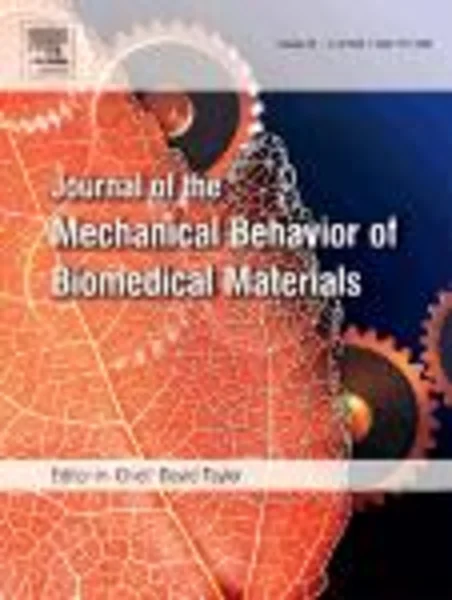-
age-dependence of intracranial viscoelastic properties in living rats
جزئیات بیشتر مقاله- تاریخ ارائه: 1394/01/01
- تاریخ انتشار در تی پی بین: 1394/01/01
- تعداد بازدید: 679
- تعداد پرسش و پاسخ ها: 0
- شماره تماس دبیرخانه رویداد: -
to explore the effect of maturation on intracranial mechanical properties, viscoelastic parameters were determined in 44 live rats at ages 1–2, 10–12, 21, 56–70, and 180 days using instrumented indentation. with the dura mater intact, the apparent modulus of elasticity, the indentation modulus, and viscous behavior were measured in vivo, as well as 1 h after death. in a separate group of 25 rats, brain water, and protein content were determined. a significant increase of the elastic and indentation moduli beginning at 10–12 days after birth and continuing to 180 days was observed. the creep behavior decreased in the postnatal period and stabilized at 21 days. changes in intracranial biomechanical properties corresponded to a gradual decrease of brain water, and an increase in total protein content, including glial fibrillary acidic protein, myelin basic protein, and neurofilament light chain. elastic properties were not significantly different comparing the live and dead states. however, there were significant postmortem changes in viscous behavior. viscoelastic properties of living rat intracranial contents are shown to be age dependent, reflecting the physical and biochemical changes during postnatal development. this may be important for understanding why young and mature brains respond differently in situations of brain trauma and hydrocephalus.
مقالات جدیدترین رویدادها
-
استفاده از تحلیل اهمیت-عملکرد در ارائه الگوی مدیریت خلاقیت سازمانی و ارائه راهکار جهت بهبود
-
بررسی تاثیر ارزش وجوه نقد مازاد بر ساختار سرمایه شرکت های پذیرفته شده در بورس اوراق بهادار تهران
-
بررسی تأثیر سطح افشای ریسک بر قرارداد بدهی شرکت های پذیرفته شده در بورس اوراق بهادار تهران
-
بررسی تأثیر رتبه بندی اعتباری مبتنی بر مدل امتیاز بازار نوظهور بر نقد شوندگی سهام با تأکید بر خصوصی سازی شرکت ها
-
تأثیر آمیخته بازاریابی پوشاک ایرانی بر تصویر ذهنی مشتری پوشاک ایرانی (هاکوپیان)
-
بررسی محاسن و معایب عمل جراحی لاپاراسکوپی در درمان بارداری لوله ای
-
بررسی تاثیر رگه های ژیپس بر تراوش از پی سد گتوند علیا
-
the nature of the sulfur tolerance of amorphous silica-alumina supported nimo(w) sulfide and pt hydrogenation catalysts
-
determination of the cutterhead torque for epb shield tunneling machine
-
effect of bidirectioanal near field ground motions on inelastic response of 3d modeled r.c frame buildings
مقالات جدیدترین ژورنال ها
-
مدیریت و بررسی افسردگی دانش آموزان دختر مقطع متوسطه دوم در دروان کرونا در شهرستان دزفول
-
مدیریت و بررسی خرد سیاسی در اندیشه ی فردوسی در ادب ایران
-
واکاوی و مدیریت توصیفی قلمدان(جاکلیدی)ضریح در موزه آستان قدس رضوی
-
بررسی تاثیر خلاقیت، دانش و انگیزه کارکنان بر پیشنهادات نوآورانه کارکنان ( مورد مطالعه: هتل های 3 و 4 ستاره استان کرمان)
-
بررسی تاثیر کیفیت سیستم های اطلاعاتی بر تصمیم گیری موفق در شرکتهای تولیدی استان اصفهان (مورد مطالعه: مدیران شرکتهای تولیدی استان اصفهان)
-
امکان سنجی استفاده از سیستم بام آبی در شهر کرج
-
تاثیر هشت هفته تمرینات تی آر ایکس بر عملکرد جسمانی بازیکنان نوجوان پسر بسکتبالیست
-
بررسی اثرات مشترک ویژگی های اجتماعی و فشار نهادی (سازمانی) بر کیفیت حسابرسی
-
بررسی تاثیر بهبود تغییرات در حسابداری شرکت ها و کیفیت حسابرسی بر اقلام تعهدی اختیاری
-
بررسی و تحلیل نقدهای فمینیستی ادبیات کودک و نوجوان در نشریه تخصصی کتاب ماه کودک و نوجوان (1376-1393)




سوال خود را در مورد این مقاله مطرح نمایید :